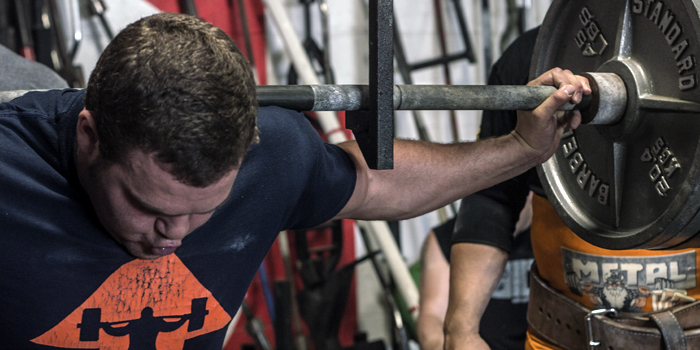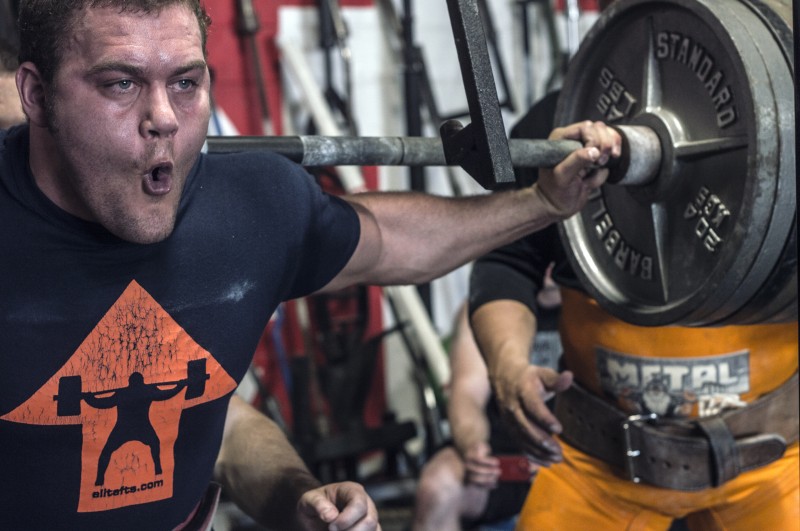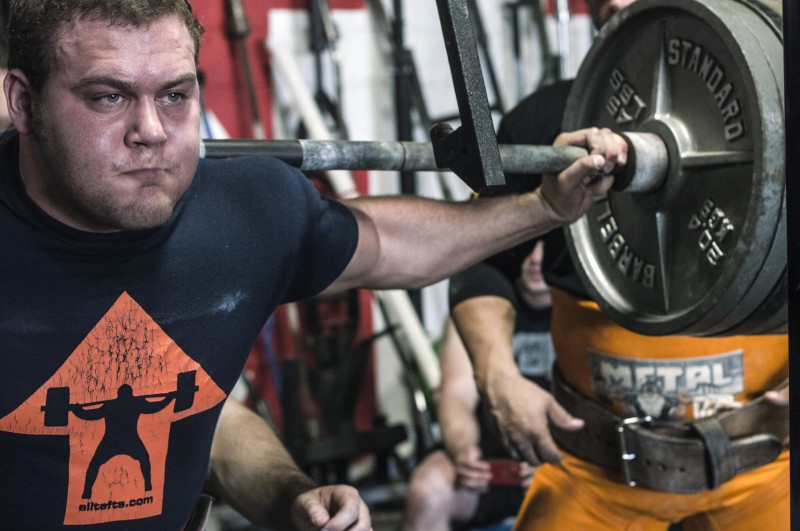
Training for powerlifting is quite simple, yet so many of us manage to screw it up. In this article, I’m going to explain how I go about arranging training for myself and for my clients.
First thing first, I like to split my training phases up into three distinct phases, or macrocycles, with each phase lasting anywhere from one to three mesocycles. The mesocycles typically last four weeks, depending on the athlete’s age, weight, experience level, and time until competition. Each mesocycle is split up into a repeating series of three hard microcycles, followed by one restorative or “deload” microcycle. Each microcycle lasts one week and consists of anywhere from three to six training sessions, again depending on the athlete’s age, weight, experience level, and time until competition.
The three macrocycles I implement include the following: A hypertrophy and volume phase, a general strength phase, and finally a competition preparation and peaking phase. I like to arrange them in that order. I will talk about each of these phases in more detail.
The Training Session
First, let’s talk about what an individual training session should look like. I like to layer each individual session into five parts: the warm-up, the primary movement(s), the secondary movement(s), the tertiary movements (accessory exercises), and the cool-down.
RELATED: Hypertrophy and the Non-Hormonal Stimuli That Make Muscle Grow
The warm-up should consist of two parts: mobilizing and stabilizing. Mobilizing includes modalities such as static stretching and myofascial release to ensure that the athlete is able to move through the proper range of motion required for a given session's movements. Stabilizing consists of ensuring proper stabilization of the joints through that range of motion. For bench press, this could be performing band pull-aparts to work on or cue proper shoulder stabilization, and for squats this could be as simple as a couple minutes of 90/90 diaphragmatic breathing.
The primary movement is the main focus for the day and should be one of the competitive movements or a very close variation. For squats the main movement is generally a competition style squat, but could possibly be a slight variation from the competition style such as changing stance width, bar placement, or the type of bar used. Closer to competition this movement should be very specific, whereas farther away from competition it could be slightly less specific. Whichever variation or specific movement you choose should remain constant throughout the macrocycle. The primary exercise will typically be performed immediately following the warm-up.
Next up is the secondary movement or movements. These exercises should be a variation of the competition movement and can stray a little farther away in specificity. An example of a secondary movement I would program in for the squat could range anywhere from a SS Yoke Bar box squat to a high bar pause squat, or possibly both for a lifter that needs more volume per session. Smaller and less experienced athletes they may be able to handle two secondary movements per session, but most athletes will be fine with just one. The goal of the secondary exercise is to address a weakness and/or correct a technique issue (an additional point to know: one is usually caused by the other) by altering the leverages and/or range of motion of the competitive movement.

Now for the tertiary movements. These movements are commonly referred to as accessory exercises. When selecting accessory exercises there are two questions to consider: Is this movement safe? Will this movement strengthen a weak muscle group? Accessory movements should not load the spine and should not put any joint in an unstable position. Keeping with the squat for our example, accessory movements for the squat may include glute ham raises and barbell hip thrusts if your squat is limited by weak glutes and hamstrings. I usually like to pick anywhere from two to four movements here depending on which phase of training the athlete is in, as well as the athlete's individual needs.
And finally, the cool-down. The cool-down should be similar to the beginning of the warm-up, simply mobilizing and releasing tight or problematic areas with modalities such as static stretching, dynamic stretching, and myofascial release.
Macrocycles
The first macrocycle entered should be the hypertrophy and volume phase. In this phase we have two goals: build muscle and increase work capacity. Work capacity can be thought of as the amount of work the athlete can perform and recover from per body part, per session, per week. I like to think of it as increasing the size of a car's fuel tank and increasing the size of the motor. With a larger fuel tank (work capacity) and a bigger motor (muscles) the car is going to be able to run harder for longer (lift more weight more often). During this phase I suggest athletes train with minimal equipment, (i.e. no belt, no knee-wraps, etc.). But hear me out, I don’t implement this because I think lifting without a belt or wraps is going to somehow make your core magically stronger or because you to build more muscle. Arguments can be made either way there. Some will say no belt requires more core strength and others will argue that using a belt recruits more core muscle activation. However, not using a belt and wraps will require the athlete to use less weight. Using less weight is going to decrease the risk of injury and likely enable the athlete to do more sets and more reps per session.
During the hypertrophy and volume phase, I like to keep the training percentages between 50-70% on the competition movements and/or their variations. The percentage used will again depend on several factors but this time not just age, weight, experience level, and the amount of time until competition. It will also depend on the sets and reps for that session and the amount of equipment generally used for that lift in competition. In linear fashion, I like to start at the lower end of the spectrum for both total volume and percentages then work up from there by increasing volume and/or intensity (load on the bar). Keep in mind that volume can be defined as sets x reps x load and can be manipulated in a multitude of fashions. As a general recommendation, I suggest three to six sets of six to 12 repetitions on both the primary and secondary movements. Less experienced and lighter athletes should be on the higher end of that spectrum with more experienced and heavier athletes being on the lower end of that spectrum. Rest between sets should somewhere around two to three minutes during this phase, with rest between exercise movements being around five minutes.
Next up is the general strength phase. In this phase, there’s really just one goal: increasing strength in the squat, bench press, and deadlift while maintaining the size and work capacity built in the previous hypertrophy and volume phase. During this phase, I recommend that the athletes start to add back in more equipment such as a belt and light wraps or tighter sleeves. The purpose behind adding these back in is quite simple: to allow the athlete to move the heavier weights more proficiently.
MORE: Daily Undulating Periodization: Conjugate Adapted for Raw Lifters
In the general strength phase, I like to keep training percentages in the 70-85% range on the primary movements and in the 55-70% range on the secondary movements, again depending on the individual athlete’s needs. During this phase, I recommend three to six sets of three to six repetitions for both the primary and secondary movements, again with less experienced and lighter lifters on the higher end and more experienced and heavier lifters on the lower end of that spectrum. During this phase, the primary and secondary movements should be much more specific to the competition movements. This phase is really the bread-and-butter of training. The athletes are developing the neural and muscular adaptations required to be proficient in the movements. Rest periods between sets during this phase may be extended to three to five minutes between sets with five to seven minutes between exercise movements.
Following the general strength phase, we have the competition preparation and peaking phase. During this phase athletes will train the primary movements in the 80% and above range and the secondary movements, if applicable at this point, in the 65% and above range. The goal of this phase is simple: to prepare you for the best possible performance in the competition lifts on the day of competition or the test day for those who aren’t competing (which you should be, by the way). During this phase of training, I suggest that all competition equipment is worn in training and all lifts to be completed to the standard required in competition (i.e. squats below parallel, bench presses paused, and deadlifts fully locked out and controlled down). The purpose behind this is to make sure nothing feels foreign on meet day. As the old saying goes, “Practice how you play!”
When laying out the peaking phase I like to work my way backward from realistic goals for the day of the meet. The length of this macrocycle will depend heavily on the athlete’s size and experience level. For a lightweight novice or female novice lifter this phase of training may only last one mesocycle (four weeks), whereas, for a super-heavyweight advanced lifter, the peaking phase may last three or even four mesocycles (12-16 weeks).
RELATED: Understanding the Strategy of Periodization
At the very beginning of a peaking phase, the volume (sets x reps x weight) will be higher and the intensity (remember, that means load on the bar) will be lower. Then as the training cycle progresses forward the volume decreases while the intensity increases, working our way towards performing three maximal or near maximal attempts in each competition lift on the same day. For more taxing lifts such as the deadlift, the volume will need to be decreased much earlier during this phase, whereas with less taxing lifts such as the bench press, the volume will taper down much later in the training cycle. The squat will fall somewhere in between those two depending on the individual athlete. Rest periods between sets should be until full recovery during this phase, which is hopefully no more than 10 minutes between sets and no more than 10 minutes between movements.
Perhaps the most important part of the peaking process is the time off from training before competition. For a lightweight novice or female athlete, this may mean taking their last heavy training session three days before the competition, whereas for an advanced super-heavyweight male athlete this time may be anywhere from two to three weeks off after their last heavy training session. For most of the athletes reading this, your time will fall somewhere in between those ranges and you will need to take your last heavy training session roughly one or one and half weeks out from the day of competition. This is, of course, assuming you’re somewhere between novice and advanced.
Recovery
The last thing that I would like to touch on briefly is recovery modalities — more specifically active recovery. If you want to increase your recovery time between sessions then you should be performing some sort of active recovery work two to three days a week for 20-30 minutes at a time. This could be as simple as walking, biking, or rowing at a light leisurely pace just to get the blood pumping. Implement this into your routine and you may be dumbfounded at the impact it makes in not only your recovery and training but also your overall health.
Conclusion
Training for powerlifting isn’t all too complex. You should be breaking your training up into a few distinct phases throughout the year (this is called periodization) focusing on hypertrophy and work capacity, general strength, and preparing for competition. Each individual session should have a few distinct components including a warm-up, primary movement, secondary movement, a few tertiary movements, and a cool-down. Implement this schedule or a similar one into your training year and you’re sure to make some progress.
Timothy Paynter is a 90-kilogram powerlifter and has competed in multiple federations including the USPA, USPF, and APA. He has a 1,785-pound raw total without wraps in the USPA. His best lifts in competition are a 611-pound squat, a 446-pound bench press, and a 738-pound deadlift. He has been doing online and in-person powerlifting coaching for two and a half years. Timothy has a Bachelor of Science in Biology and currently works as a high school biology teacher.











5 Comments